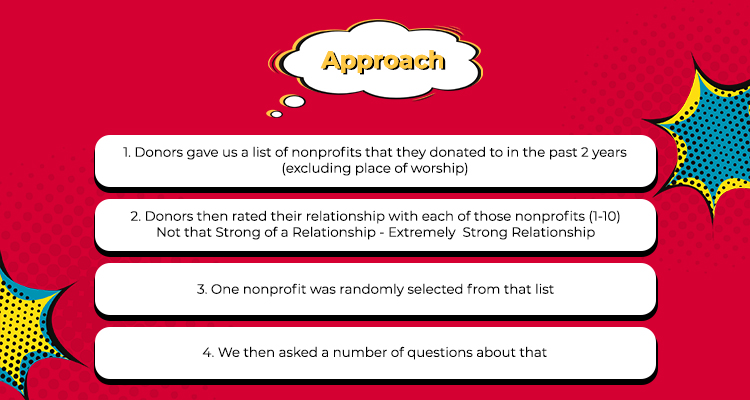Foreword by Tim Kersten
Are donors fickle or do they simply feel forgotten about?
It can be tempting to analyze your nonprofit’s donor attrition metrics and conclude that, despite your best efforts, those who stop giving simply lose interest for some inexplicable reason, and drift away. It’s inevitable. No donor gives forever. True for some but not for all.
What if your best efforts to retain your donors aren’t stimulating the deep-felt emotions donors must have to sustain their support?
That’s too often the case, which is why RKD Group commissioned a national study of donors to better understand the factors important to them in securing their loyalty to a nonprofit over a long period of time.
The world is evolving. Donor sentiment is shifting. How can you track with the changes, stay ahead of the curve, and be better at retaining your donors through data-oriented, personalized connection at scale?
I encourage you to dig into our research findings. Discover the new and interesting ways you can strengthen your relationship with your donors through better listening and more thoughtful response to what you hear.
I wish you every success!
Tim Kersten
CEO
RKD Group
Executive Summary
How do we get donors to stick around?
It’s a fundamental question at the heart of every nonprofit’s fundraising program. Yet, clearly, it’s a struggle for many. In fact, statistics from the Fundraising Effectiveness Project show that industrywide retention numbers consistently sit below 50%.
That means most nonprofit organizations are losing more than half their donors. Year after year. Again and again. As quickly as they come in, they’re right out the door.
But why is retention such a challenge?
There are multiple dimensions to that answer. RKD Group set out to explore one: How do donors feel?
More specifically, how do donors feel about the organizations they support?
RKD commissioned McQueen Mackin and Associates to conduct a research study on what drives deeper donor relationships.
We didn’t aim to understand what inspires someone to give to a nonprofit organization for the first time. We wanted to uncover what creates those long-lasting commitments.
Our findings indicate that the biggest differentiators between donors who had weak and strong relationships centered around the notions of feeling valued and involved.
To accomplish this, we set out to determine how specific emotional, rational and behavioral attributes differ among donors who feel strongly about a nonprofit they support and those who don’t.
Ultimately, this is all about feeling— understanding how your marketing and fundraising strategies make a donor feel. For years, nonprofit marketers have used phrases like “donor-centric,” yet as an industry, we too often miss the mark on understanding our donors and placing them in the center of how we communicate.This is about talking with donors versus talking at them. Take a moment and think about your communication practices. Do you talk with donors? Or at them?
Simply put: Donors want to be heard. So, nonprofits: Listen up!
How We Asked
The data in this report comes from an online survey of 1,334 U.S. donors, commissioned by RKD Group. This study was conducted in May 2022 by McQueen Mackin and Associates, a market research firm that is dedicated to the research and data that drive psychology and human behavior.
Survey respondents make up a nationally representative sample of people who gave at least $25 in the previous calendar year (excluding place of worship). The survey was controlled for sex (51% men, 49% women) and age (30% each of Millennials and Generation X; 40% Baby Boomers). Additional controls were put in place to ensure that inaccurate and invalid responses were excluded.

We asked survey respondents to provide up to seven names of nonprofits they’ve donated to in the last two years (excluding their place of worship). We asked them to include both nonprofits they feel they have a strong relationship with and nonprofits they have a weaker or no relationship with.
Next, we asked them to rate their relationship with each nonprofit on a 1-to-10 scale. Each respondent was then randomly assigned one nonprofit from their list for a series of questions around:
Three relationship segments
Weak (scores 1-5)
Mid (scores 6-8)
Strong (scores 9-10)
- The strength of their relationship with the nonprofit
- Beliefs about the nonprofit
- How the nonprofit made them feel
- Communication levels
- Engagement channels
Based on the “relationship score” they gave to the nonprofit they were randomly assigned, each respondent was classified into one of three segments—Weak (scores 1-5), Mid (scores 6-8) and Strong (scores 9-10).
Throughout this study, we used these segments to analyze what drives donor relationships. Frequently, you’ll see us compare the “gap” between weak and strong relationships to understand the primary drivers
Donors Want to Feel Valued
We know donors give to causes they are passionate about. Often, they have a strong personal or emotional tie to these causes. But what leads them to pick one charitable organization over another one in a particular causeand to stay committed to that organization over time?
Attributes like whether the organization is trustworthy (29% gap), puts the donation to good use (35%) and makes a great impact (37%) played less of a role in driving belief than whether a donor feels valued and important.
This doesn’t mean those factors aren’t important. It means that transparency is secondary to authenticity.This is all about how you create and mature relationships. Think about the relationships in your own life—the people close to you who expect authenticity from you, as well as transparency. Can you have one without the other? We think so—and too often organizations focus on transparency while not being fully authentic in communication with donors.
The areas with the biggest gaps between strong and weak included feeling connected to the organization (68%) and good communication that goes both ways (58%).
Donors with strong relationships also said the nonprofit values their opinion (57%), cares about their point of view (54%) and keeps them informed (52%). Communication isn't a one way street. That's talking at someone, not with someone. One of the more fascinating aspects of this study is to reflect on how you listen to donors, as opposed to how you talk to them.
This is all about how you create and mature relationships. Think about the relationships in your own life—the people close to you who expect authenticity from you, as well as transparency. Can you have one without the other? We think so—and too often organizations focus on transparency while not being fully authentic in communication with donors.
These feelings are often connected with stewardship, and we see it in the data as well. 94% of donors with strong relationships said they frequently or sometimes receive a “thank you” for their support. Thank yous, however, are mere table-stakes for all donors, whether the relationships are weak or strong.
Even the terms respondents used to describe themselves varied based on the strength of their relationship. Those with strong relationships were more likely to say they were a volunteer (32% gap), activist (26%), patron (24%) or ambassador (22%), compared to a donor (0%) or supporter (13%).
Feeling Involved Strengthens the Relationship
Our research found that the other key factor in a strong relationship was the familiarity respondents had with a nonprofit organization.
In this case, familiarity doesn’t mean brand awareness or knowledge of the charity’s cause or mission. This familiarity is how donors perceive their awareness of an organization’s programs, capabilities and activities—in other words, how involved the donor is in the organization.
And the more involved a donor is with a charitable organization, the stronger the relationship becomes.
Engagement is the biggest differentiator toward feeling involved.Just like being donor-centric, engagement is a word that is so jargony that we don't always think clearly about what it means for those that support us.
Strong relationships err towards deeper intimacy. Feeling involved. So, don't see this and pass it off in a jargony way.
Think deeply about what it means to be engaged in someone's life—and how that translates into ways your donors might engage with you.
We think it's interesting that the combination includes passive communication (like website and social media) as well as active communication (like directly with staff or at events). It points to well-rounded communication as deeper engagement.
Our survey found that donors with strong relationships were far more likely to visit a nonprofit’s website, communicate with staff, engage on social media, attend events or volunteer.
Donors with strong relationships are also more likely to watch a nonprofit’s videos, attend events, volunteer or download an ebook.
We find it interesting that the combination includes passive communication (like website, video and social media) as well as active communication (like directly with teams on staff or at events).
Donors with strong relationships actually expect more frequent communication...
It points to well-rounded communication as deeper engagement.
But how much communication is right?
“Are we communicating too much?” is a common concern among nonprofit organizations. But donors with strong relationships actually expect more frequent communication from the organizations they support. And donors with weak relationships say they don’t receive enough communication.
Relationship Impact on Giving
Obviously, giving amount can be an indicator of a relationship. That’s why giving levels are important in all applications of segmentation and modeling. But again, in this study we’re thinking about how feelings relate to behaviors.
Take a look at the gap between strong and weak relationships as it relates to giving over 12 months. In particular, look at how the gap changes- and how important that $100 mark becomes to the trajectory of a strong relationship.All the more reason to consider how giving levels factor in to your personalization practices.
The results affirm the importance of stewardship and that most stewardship tactics can strengthen the relationship with a donor.
When it comes to charitable giving, we see a bigger gap between donors with strong relationships and those with weak relationships in digital channels like social media, email, text messaging and website. Offline channels like TV, in-store, radio and direct mail show similar support across relationship types.
What’s the catch here? Maybe it’s that nonprofits have a pretty consistent approach to communicating on these more traditional channels. But some organizations do a much better job than others in how they connect to donors in digital channels.
The Influence of COVID-19
| As we commissioned this research, we also wanted to note how much the COVID-19 pandemic was a factor in donor relationships. First, we asked donors whether they gave to the specific nonprofit listed prior to the pandemic. 85% said yes—with percentages going slightly higher as relationships got stronger. |
|
We then wanted to understand if the pandemic influenced how much they gave. While most respondents indicated they gave the same amount as before the pandemic (76%), those with strong relationships were more likely to give more. |
Similarly, donors with strong relationships were more likely to say that the pandemic played a large role (44%) in their decision to give to that particular nonprofit.
|
Finally, 37% of donors with strong relationships felt their relationship with the nonprofit got stronger throughout the pandemic. |
About the Researchers
About RKD Group
RKD Group is a leading fundraising and marketing services provider to hundreds of nonprofit organizations. RKD Group's multichannel approach leverages technology, advanced data science and award-winning strategic and creative leadership to accelerate net revenue growth, build long-term donor relationships and drive online and offline engagements and donations. With a growing team of professionals, RKD Group creates breakthroughs never thought possible.
About McQueen Mackin and Associates
Using market research to provide insights into how to best ignite donor passions, McQueen Mackin and Associates helps nonprofit organizations raise more funds to further their cause and do more good in the world. Through years of experience and countless research projects, McQueen Mackin has developed numerous tools and models they have put to use for many nonprofits like the National Park Foundation, Susan G. Komen, The Salvation Army, St. Jude Children's Research Hospital and more. For additional information, visit mcqma.com.
Jump To Section:
Hey! hover over me... Be on the lookout for red font like this. Hover over the text to hear some extra thoughts on fundraising.

We're Here to Listen
Interested in hearing more? Or, want to chat about how you can improve your donor relationship? We're here to listen. Complete the form below and someone will get back to you ASAP.

-1.png?width=150&height=75&name=RKD-logo-red-tm%20(1)-1.png)